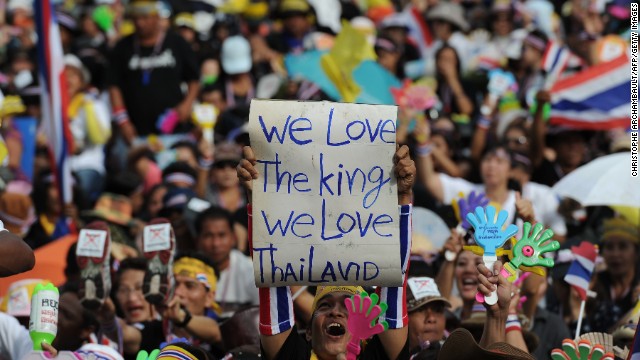Why are the protests happening in
THAILAND ?
- A failed attempt last month by the
ruling Pheu Thai Party to push an amnesty bill through parliament which
would have pardoned all those involved in political conflict in recent
years.
- Protestors believe
the bill would have allowed former
Prime Minister Thaksin Shinawatra to
return from exile.


Who is Thaksin?
- He's a deeply polarizing figure --
a billionaire telecommunications mogul who built his political power on
policies popular with Thailand's rural villagers.
- His success ruffled a lot of
feathers among the country's established elites, and critics accused him
of corruption and autocratic rule.
- He was prime minister between 2001
and 2006, when the military deposed him in a bloodless coup.
 |
What happened in
2010?
- Thaksin's ouster spurred the
protest movement that developed over the years into the widespread "red shirt" demonstrations
that occupied upscale parts of Bangkok in 2010.
- By that stage, the movement had
broadened to represent other issues, including resentment at the
military's involvement in politics and economic inequality.
- The crackdown by security forces
on the red shirts resulted in clashes that left around 90 people
dead.
- It has been described as the worst
civil violence in Thailand's history, and the country remains severely
scarred by the experience.
Are the protests happening right now
(2013) legitimate?
- They are anti- THAKSIN protests
contrary to those in 2010, which were pro-THAKSIN.
- While Thailand’s constitution
allows political demonstrations, the protestors are trying to overthrow a
democratically-elected government and replace it with an unelected
“people’s council”.

Where is THAKSIN right now ?
- He has been living in exile in a
number of different places, most recently Dubai, while continuing to play
an active role in Thai politics.
- He briefly returned to Thailand in
2008. Later that year, he was convicted by a Thai court of corruption and
sentenced in absentia to two years in prison over a controversial land
deal. Courts have also frozen billions of dollars of his assets, but he is
believed to still have a great deal of money held elsewhere.
- He's also stayed heavily involved
in Thai politics over the years, communicating with supporters via social
media and video messages. With his younger sister in power since 2011, his
influence remains strong. Critics
say Yingluck is Thaksin's puppet, but she insists she has always been
independent.
Who are the protestors?
- Mostly metropolitan and middle-class, they are a loose coalition of anti-Thaksin groups associated with the opposition Democrat Party and likely backed by Thailand’s traditional elite: big businessmen, conservative generals, aristocrats and royal advisors.
Who supports the government?
- Pheu Thai’s populist policies ensure it commands huge support in the densely-populated rural north and northeast of Thailand and among the urban working-class.
- So even if re-elections happen they are again going to win the elections !!!
Why is Thaksin such a divisive
figure?
- Protestors view Thaksin and the Yingluck government as hopelessly corrupt and as a challenge to the authority of Thailand’s revered monarch, King Bhumibol Adulyadej.
 |
What is likely to
happen next?
- Questions remain over the ability
of Yingluck's government to maintain order in the capital and weather the
heavy political pressure in Parliament.
- Some observers are concerned that
government supporters, tens of thousands of whom rallied in Bangkok on
Sunday, could clash with opposition demonstrators.
- Yingluck has said authorities
would "absolutely not use violence" to disperse the
demonstrators.
- Even if Yingluck survives the
"no confidence" motion against her, the situation appears
unlikely to calm down soon.
What is the latest news
?
· Thailand's government has rejected calls to delay February's
election, amid increasingly violent protests in which a policeman has been shot
dead.
· The Electoral Commission urged the postponement over safety
fears for candidates on the campaign trail.
· But government officials said parliament was already dissolved
so there was no legal reason for a delay.
· The protesters want the government to stand down and be replaced
by an unelected "people's council".










